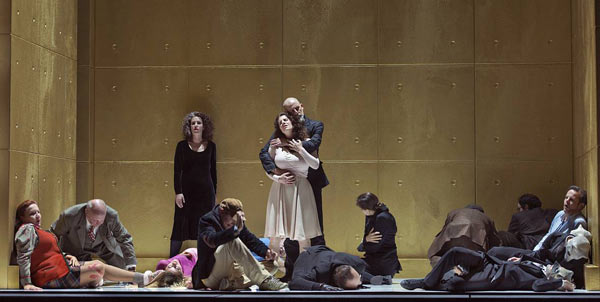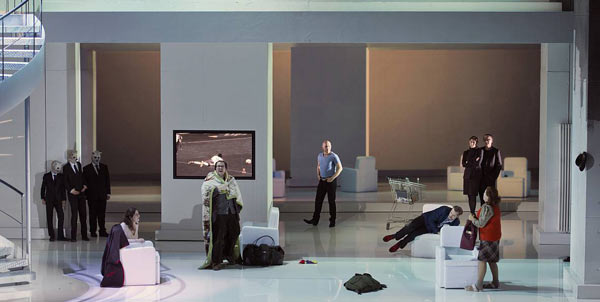

Bluthaus – Photo by Ruth Walz
In his libretto, Klaus has essentially written a series of conversations. But he reduced them to fragments, bits of speech that are tossed from one character to another like a fast-paced basketball game. As the narrative bounces between the main character, Nadja (Sarah Wegener), a young woman trying to sell her family home after her parents both die suddenly, and the potential buyers who attend the open house, the central mystery of the plot is slowly, painfully revealed. Nadja’s father abused her, and her mother eventually killed the father before taking her own life inside the house. Klaus exposes this tragedy through a fog of constant chatter during the open house, which eventually builds into a peak of frenzied panic as realisation dawns. Throughout, the ghosts of the parents haunt Nadja from behind the fireplace, singing only a syllable or two of a word before disappearing again.
At times, Haas used very little music to set this libretto. He let the characters- sometimes as many as fourteen on stage at once- speak or sing through each other in a kind of storytelling counterpoint, set only against percussive elements or swelling, microtonal harmonic blocks. Percussion was used effectively throughout, with a bass drum amplified with a subwoofer heightening the sense of anxiety. Haas echoed the obsessive repetition in the libretto with similarly anxious gestures in the strings and winds. A swelling dominant-seventh chord with shimmering microtonal overtones always heralded the appearance of the ghostly parents, a detail which enhanced their simple haunting monosyllables. As the anxiety of the open house increased, the music built in intensity, culminating in a very long, almost intolerably overwhelming climax. Near the end of the opera, as some of the characters begin to find some clarity, a simple, unison, tonal melody began in the brass, looping in variations over increasingly complex harmonic situations until the end of the opera.

Bluthaus – Photo by Ruth Walz
As always, the Klangforum Wien performed this dense and complex score with subtlety and precision. Conductor Peter Rundel had the huge task of not only leading the orchestra, but playing traffic cop for the dozens of characters on stage all trying to coordinate their simultaneous lines with the orchestra. He kept everything running smoothly, though sometimes without enough shape and differentiation between contrasting sections. For the most part, though, the small but powerful details of both libretto and score were realised beautifully. Soprano Sarah Wegener as Nadja matched her beautifully huge voice with subtle acting, which let the character breathe throughout this intense role.
The staging of this production also contained tiny, effective details which helped to differentiate the huge cast of characters that constantly arrived and left the stage. Costumes by Andrea Schmidt-Futterer firmly placed characters as either upper- or lower-class, and hinted at their values without being overly stereotyped. As the many open house visitors arrived, they imposed their own ideas and habits on the house, which was a strikingly white, modernist set designed by the director, Peter Mussbach. A particularly effective video, incorporated into the story, helped to depict the deeply creepy and evil side of the father’s character.
Haas said that he wanted to create this opera for the shockingly large portion of the population who have suffered abuse at the hands of parents or other family members. By reducing both music and speech to their barest and most emotional elements, Bluthaus is an intense but sensitive tribute to victims who are often left with no words at all.
